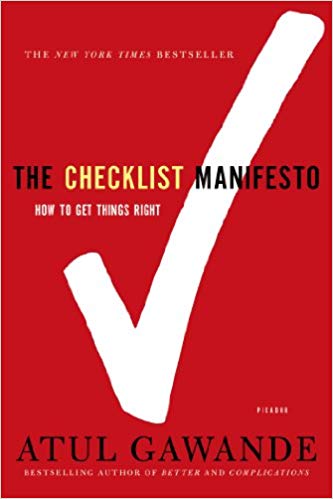

This article is an excerpt from the Shortform summary of "The Checklist Manifesto" by Atul Gawande. Shortform has the world's best summaries of books you should be reading.
Like this article? Sign up for a free trial here .
Highly trained, experienced, and capable people regularly make avoidable mistakes. Some can be fatal. After experiencing his own mistakes and observing those of colleagues, Boston surgeon Atul Gawande set out to learn why smart people make avoidable errors and how to prevent them. This is how to avoid mistakes at work.
We’ll cover why people make mistakes at work, especially in certain professions, and how to avoid mistakes at work.
Why Do I Keep Making Mistakes at Work?
The result of Gawande’s research is The Checklist Manifesto: How to Get Things Right, in which Gawande proposes a simple solution to making mistakes at work: a checklist. This is how to avoid mistakes at work.
The book chronicles his exploration of the uses and benefits of checklists in many fields, including aviation, construction, and medicine. While not a how-to manual, his book builds the case for checklists and makes a plea for widespread adoption of checklists as a safety net for human fallibility.
He argues that we fail to get simple things right because in numerous professions — for instance, medicine, engineering, finance, business, and government — the level and complexity of our collective knowledge has exceeded the capacity of any individual to get everything right. Next time you’re wondering, Why do I keep making mistakes at work?, remember that your job is likely advancing quickly and there’s too much information for one brain to keep track of.
Most professions, especially medicine, have traditionally responded to failure by requiring more training and experience. Training of medical personnel, police, engineers, and others is more extensive than ever. But while training and experience are important, expertise can’t eliminate human fallibility. What’s needed is a different strategy for preventing failure that takes advantage of knowledge and experience but also compensates for human flaws. The solution is a checklist.
Increasing Complexity
To understand how easy it is to make mistakes at work, despite our ability as humans to accomplish amazing things, consider how complex medicine has become as it has advanced.
An Israeli study several decades ago showed that the average ICU patient required 178 actions or procedures a day. We have a greater-than-ever chance to save someone who’s seriously ill, but it requires both deciding the right treatment and ensuring that 178 tasks are done correctly each day. There’s as much chance to harm a patient as to help.
In complex environments, checklists can help to prevent failure by addressing two problems:
- Our memory and attention to detail fail when we’re distracted by more urgent matters.
- People have a tendency to skip steps even when they remember them.
Checklists protect against failures because they remind you of the minimum necessary steps by spelling them out. They allow you to verify each step while also establishing and instilling a performance standard.
How to Avoid Mistakes at Work
In complex environments, checklists can help to prevent failure by addressing two problems. This is how to avoid mistakes at work:
1) Our memory and our attention to detail fail when we’re distracted by more urgent matters. For instance, if you’re a nurse, you might forget to take a patient’s pulse when she’s throwing up, a family member is asking questions, and you’re being paged.
Forgetfulness and distraction are especially risky in what engineers call all-or-none processes, where if you miss one key thing, you fail at the task. For instance, if you go to the store to buy ingredients for a cake and forget to buy eggs, you can’t make the recipe because it wouldn’t work without eggs. The consequences are more serious if a pilot misses a step during take-off or a doctor misses the key symptom.
2) People have a tendency to skip steps even when they remember them. In complex processes, certain steps don’t always matter, so people may play the odds and skip them. For instance, if measuring all four of a patient’s vital signs (pulse, blood pressure, temperature, and respiration) only rarely detects a problem, you might become lax about checking everything.
Checklists protect against such failures because they remind you of the minimum necessary steps by spelling them out. They allow you to verify each step while also establishing and instilling a performance standard.
Saved by a Checklist
Gawande knows that checklists are how to avoid mistakes at work. In 2007 as soon as the Safe Surgery Checklist took shape, Gawande began using it in his surgeries. Hardly a week went by without the checklist enabling the team to catch something they would have otherwise missed.
For instance, in one week, there were catches in five cases, including:
- A patient hadn’t gotten the antibiotic she should have.
- The surgeon learned of a breathing risk at the last minute.
- The team discovered drug allergies, equipment problems, confusion about medications, and labeling mistakes.
In another case, the checklist saved the patient’s life. Gawande was performing surgery to remove a man’s adrenal gland because of a tumor. He made a catastrophic tear, resulting in massive bleeding and cardiac arrest. But due to the checklist, four units of the right blood were available and ready to go — this step saved the patient’s life. In addition, staff members were prepared to work as a team and everyone stayed calm and did what was needed. Although he had a long recovery, the patient survived. Learn from Gawande on how to avoid mistakes at work.
Creating a Checklist
(Shortform note: also see the “A Checklist for Checklists.”)
Checklists are how to avoid mistakes at work. Before creating a checklist, decide two things:
1) Define a clear ‘“pause point” at which the checklist is to be used (unless the moment is obvious, such as when something malfunctions).
2) Decide whether to create a Do-Confirm list or a Read-Do list.
To use a Do-Confirm checklist, team members perform their jobs from memory. Then they stop and go through the checklist and confirm that they completed every item on the checklist. In contrast, to use a Read-Do checklist, people carry out each task as they check it off, like a recipe.
(Shortform note: Choose the type of checklist that makes the most sense for the situation. For instance, a Read-Do list could be used when the sequence needs to be exact or the entire effort will fail, like in operating machinery or listing emergency tasks. A Do-Confirm list gives more freedom and is allowable when the stakes are lower, and a forgotten step can be done later out of sequence.)
Once you’ve chosen which type of checklist you’re creating, follow these guidelines:
- Keep the checklist short, typically five to nine items, which is the limit of short-term memory. After 60 to 90 seconds, a checklist becomes a distraction from other things. People are likely to skip or miss steps.
- Focus on the “killer” items or steps that are most dangerous to miss but that are still sometimes overlooked.
- Remember that checklists are not supposed to be how-to guides. They are quick, simple tools to aid the recall of experts.
- Keep wording simple and exact.
- Use language and terminology familiar to the user.
- Fit the checklist on one page.
- Avoid clutter and unnecessary or distracting colors.
- Use upper and lowercase text in a sans serif font for ease of reading.
Test your checklist in the real world — have people use it and provide feedback. Boorman tests his checklists in a flight simulator. Language that you think is clear may not be to someone else. In practice, things are always more complicated than anticipated. Keep revisiting and testing the checklist until it works consistently.
A checklist is how to avoid mistakes at work. Keep one handy so you stop wondering, Why do I keep making mistakes at work?
———End of Preview———

Like what you just read? Read the rest of the world's best summary of "The Checklist Manifesto" at Shortform . Learn the book's critical concepts in 20 minutes or less .
Here's what you'll find in our full The Checklist Manifesto summary :
- How checklists save millions of lives in healthcare and flights
- The two types of checklists that matter
- How to create your own revolutionary checklist






